BM563 Operations and Service Management: ASOS PLC Efficiency Analysis
VerifiedAdded on 2023/06/17
|9
|3147
|371
Report
AI Summary
This report examines the operations and service management practices at ASOS PLC, focusing on the impact of Total Quality Management (TQM) on organizational efficiency. It assesses how TQM, with its components like customer-centered management and continuous improvement, enhances product quality, reduces costs, and improves customer satisfaction at ASOS PLC. The report further explores the integration of technology, particularly information technology, in supporting TQM processes, including data management and performance review. It identifies supporting functions, such as employee commitment and a culture of continuous improvement, that are crucial for the success of TQM implementation. The analysis considers both the advantages and limitations of TQM, providing a comprehensive overview of its role in ASOS PLC's operational strategy. Desklib provides access to similar solved assignments and study tools for students.
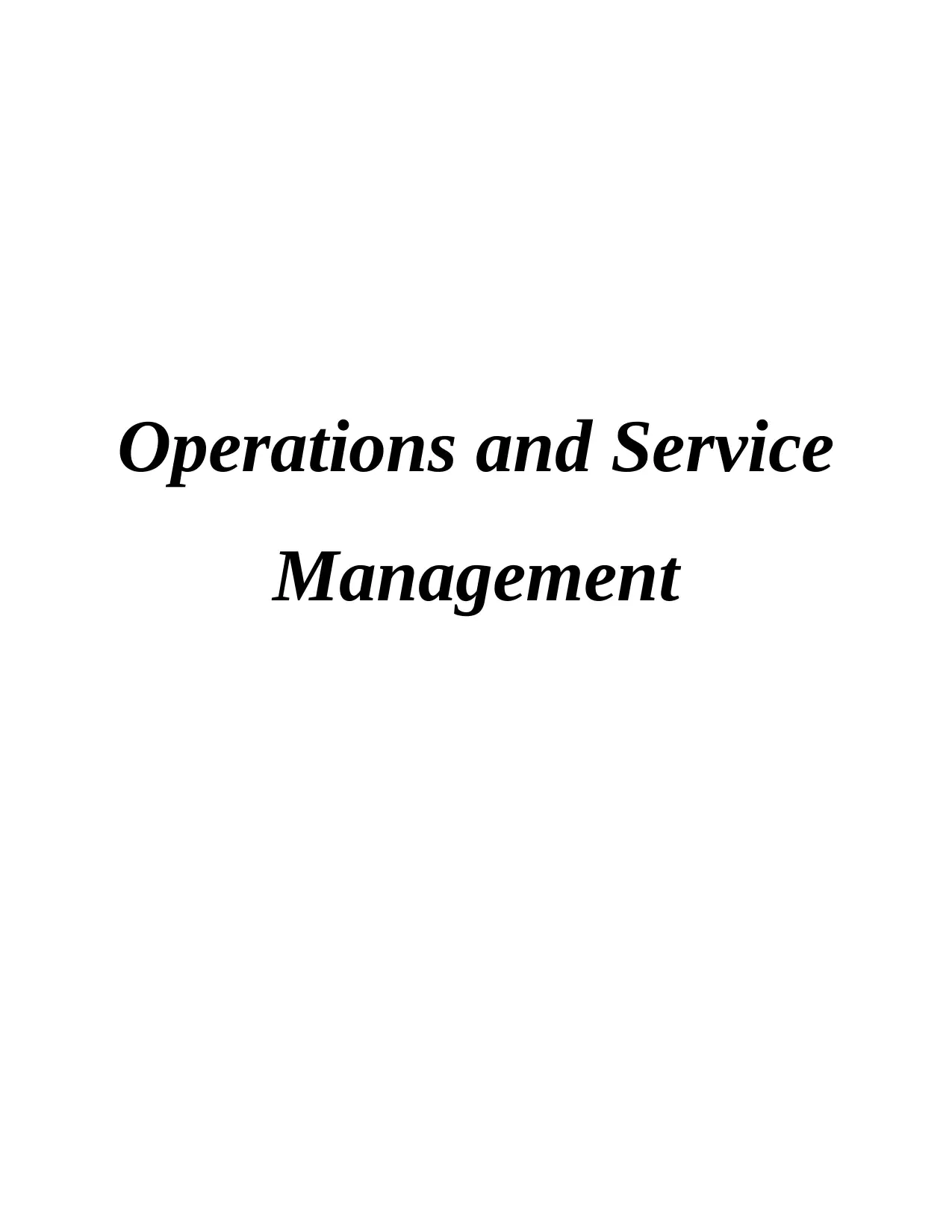
Operations and Service
Management
Management
Paraphrase This Document
Need a fresh take? Get an instant paraphrase of this document with our AI Paraphraser
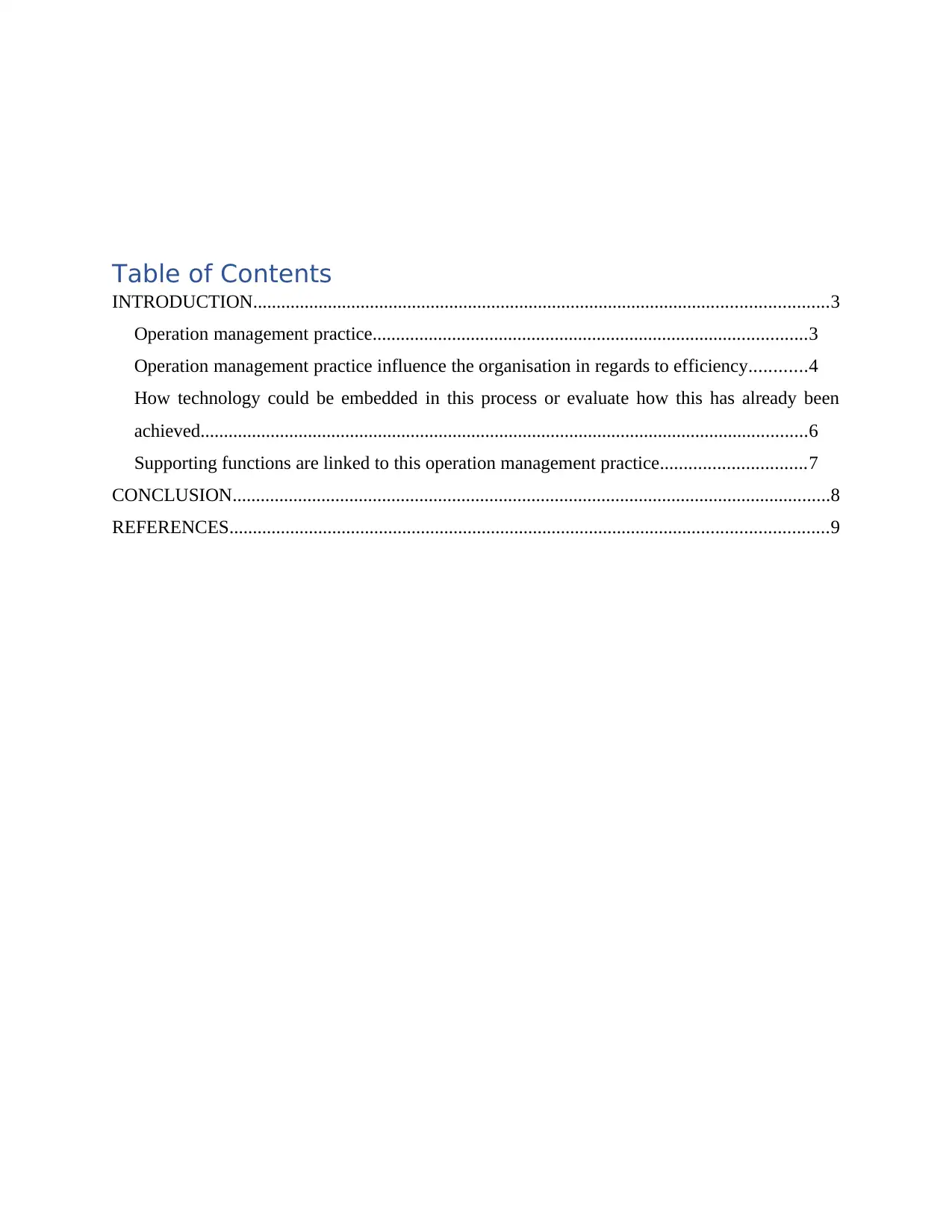
Table of Contents
INTRODUCTION...........................................................................................................................3
Operation management practice.............................................................................................3
Operation management practice influence the organisation in regards to efficiency............4
How technology could be embedded in this process or evaluate how this has already been
achieved..................................................................................................................................6
Supporting functions are linked to this operation management practice...............................7
CONCLUSION................................................................................................................................8
REFERENCES................................................................................................................................9
INTRODUCTION...........................................................................................................................3
Operation management practice.............................................................................................3
Operation management practice influence the organisation in regards to efficiency............4
How technology could be embedded in this process or evaluate how this has already been
achieved..................................................................................................................................6
Supporting functions are linked to this operation management practice...............................7
CONCLUSION................................................................................................................................8
REFERENCES................................................................................................................................9
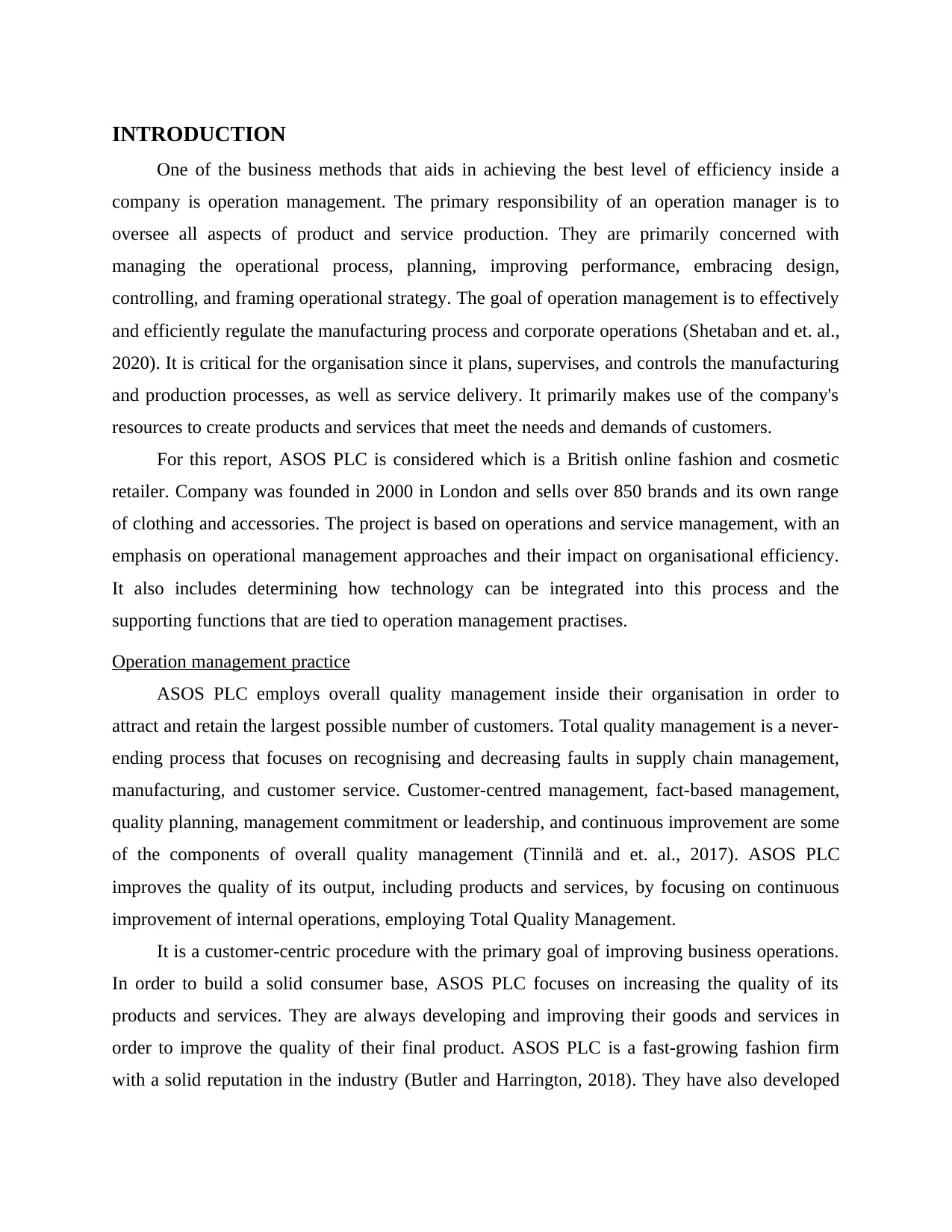
INTRODUCTION
One of the business methods that aids in achieving the best level of efficiency inside a
company is operation management. The primary responsibility of an operation manager is to
oversee all aspects of product and service production. They are primarily concerned with
managing the operational process, planning, improving performance, embracing design,
controlling, and framing operational strategy. The goal of operation management is to effectively
and efficiently regulate the manufacturing process and corporate operations (Shetaban and et. al.,
2020). It is critical for the organisation since it plans, supervises, and controls the manufacturing
and production processes, as well as service delivery. It primarily makes use of the company's
resources to create products and services that meet the needs and demands of customers.
For this report, ASOS PLC is considered which is a British online fashion and cosmetic
retailer. Company was founded in 2000 in London and sells over 850 brands and its own range
of clothing and accessories. The project is based on operations and service management, with an
emphasis on operational management approaches and their impact on organisational efficiency.
It also includes determining how technology can be integrated into this process and the
supporting functions that are tied to operation management practises.
Operation management practice
ASOS PLC employs overall quality management inside their organisation in order to
attract and retain the largest possible number of customers. Total quality management is a never-
ending process that focuses on recognising and decreasing faults in supply chain management,
manufacturing, and customer service. Customer-centred management, fact-based management,
quality planning, management commitment or leadership, and continuous improvement are some
of the components of overall quality management (Tinnilä and et. al., 2017). ASOS PLC
improves the quality of its output, including products and services, by focusing on continuous
improvement of internal operations, employing Total Quality Management.
It is a customer-centric procedure with the primary goal of improving business operations.
In order to build a solid consumer base, ASOS PLC focuses on increasing the quality of its
products and services. They are always developing and improving their goods and services in
order to improve the quality of their final product. ASOS PLC is a fast-growing fashion firm
with a solid reputation in the industry (Butler and Harrington, 2018). They have also developed
One of the business methods that aids in achieving the best level of efficiency inside a
company is operation management. The primary responsibility of an operation manager is to
oversee all aspects of product and service production. They are primarily concerned with
managing the operational process, planning, improving performance, embracing design,
controlling, and framing operational strategy. The goal of operation management is to effectively
and efficiently regulate the manufacturing process and corporate operations (Shetaban and et. al.,
2020). It is critical for the organisation since it plans, supervises, and controls the manufacturing
and production processes, as well as service delivery. It primarily makes use of the company's
resources to create products and services that meet the needs and demands of customers.
For this report, ASOS PLC is considered which is a British online fashion and cosmetic
retailer. Company was founded in 2000 in London and sells over 850 brands and its own range
of clothing and accessories. The project is based on operations and service management, with an
emphasis on operational management approaches and their impact on organisational efficiency.
It also includes determining how technology can be integrated into this process and the
supporting functions that are tied to operation management practises.
Operation management practice
ASOS PLC employs overall quality management inside their organisation in order to
attract and retain the largest possible number of customers. Total quality management is a never-
ending process that focuses on recognising and decreasing faults in supply chain management,
manufacturing, and customer service. Customer-centred management, fact-based management,
quality planning, management commitment or leadership, and continuous improvement are some
of the components of overall quality management (Tinnilä and et. al., 2017). ASOS PLC
improves the quality of its output, including products and services, by focusing on continuous
improvement of internal operations, employing Total Quality Management.
It is a customer-centric procedure with the primary goal of improving business operations.
In order to build a solid consumer base, ASOS PLC focuses on increasing the quality of its
products and services. They are always developing and improving their goods and services in
order to improve the quality of their final product. ASOS PLC is a fast-growing fashion firm
with a solid reputation in the industry (Butler and Harrington, 2018). They have also developed
⊘ This is a preview!⊘
Do you want full access?
Subscribe today to unlock all pages.

Trusted by 1+ million students worldwide
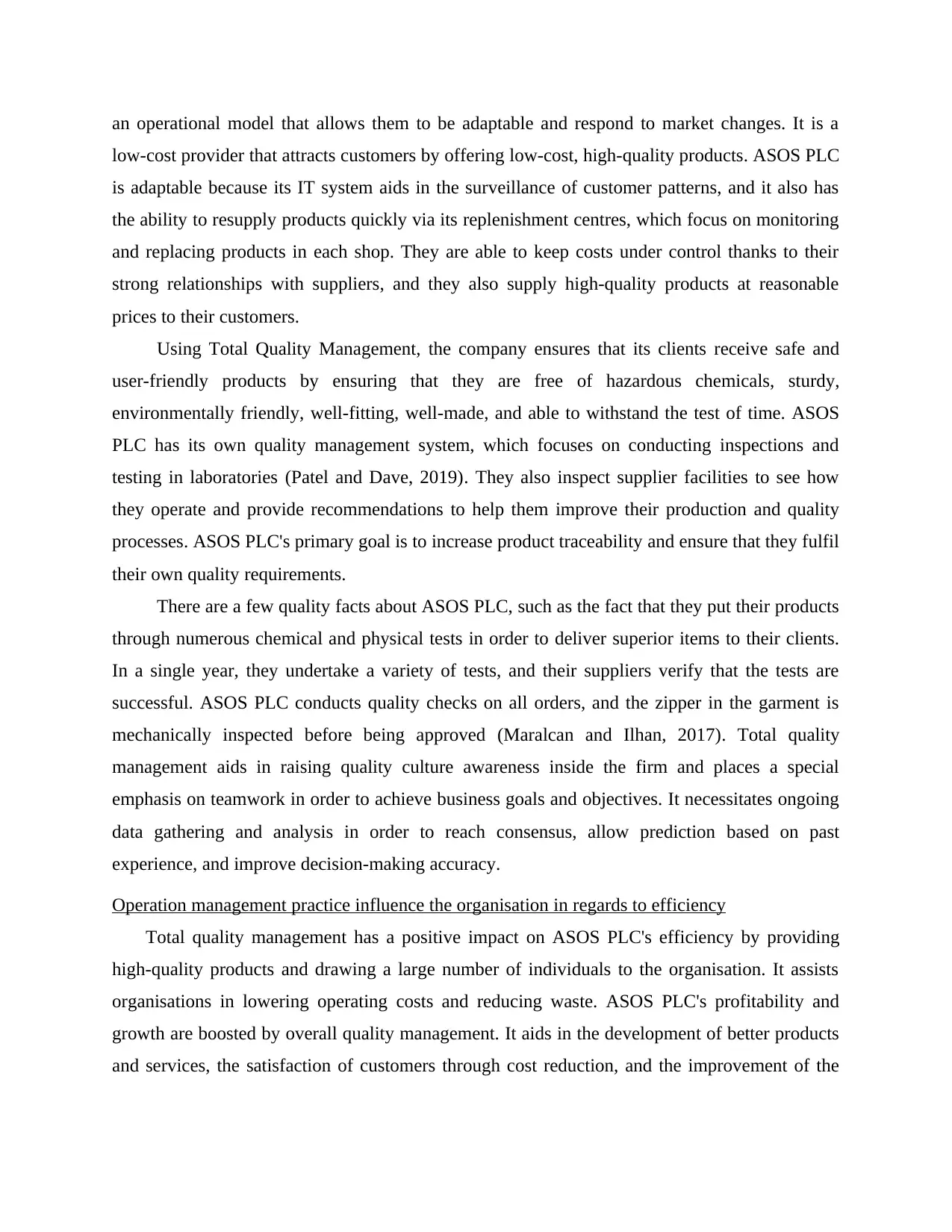
an operational model that allows them to be adaptable and respond to market changes. It is a
low-cost provider that attracts customers by offering low-cost, high-quality products. ASOS PLC
is adaptable because its IT system aids in the surveillance of customer patterns, and it also has
the ability to resupply products quickly via its replenishment centres, which focus on monitoring
and replacing products in each shop. They are able to keep costs under control thanks to their
strong relationships with suppliers, and they also supply high-quality products at reasonable
prices to their customers.
Using Total Quality Management, the company ensures that its clients receive safe and
user-friendly products by ensuring that they are free of hazardous chemicals, sturdy,
environmentally friendly, well-fitting, well-made, and able to withstand the test of time. ASOS
PLC has its own quality management system, which focuses on conducting inspections and
testing in laboratories (Patel and Dave, 2019). They also inspect supplier facilities to see how
they operate and provide recommendations to help them improve their production and quality
processes. ASOS PLC's primary goal is to increase product traceability and ensure that they fulfil
their own quality requirements.
There are a few quality facts about ASOS PLC, such as the fact that they put their products
through numerous chemical and physical tests in order to deliver superior items to their clients.
In a single year, they undertake a variety of tests, and their suppliers verify that the tests are
successful. ASOS PLC conducts quality checks on all orders, and the zipper in the garment is
mechanically inspected before being approved (Maralcan and Ilhan, 2017). Total quality
management aids in raising quality culture awareness inside the firm and places a special
emphasis on teamwork in order to achieve business goals and objectives. It necessitates ongoing
data gathering and analysis in order to reach consensus, allow prediction based on past
experience, and improve decision-making accuracy.
Operation management practice influence the organisation in regards to efficiency
Total quality management has a positive impact on ASOS PLC's efficiency by providing
high-quality products and drawing a large number of individuals to the organisation. It assists
organisations in lowering operating costs and reducing waste. ASOS PLC's profitability and
growth are boosted by overall quality management. It aids in the development of better products
and services, the satisfaction of customers through cost reduction, and the improvement of the
low-cost provider that attracts customers by offering low-cost, high-quality products. ASOS PLC
is adaptable because its IT system aids in the surveillance of customer patterns, and it also has
the ability to resupply products quickly via its replenishment centres, which focus on monitoring
and replacing products in each shop. They are able to keep costs under control thanks to their
strong relationships with suppliers, and they also supply high-quality products at reasonable
prices to their customers.
Using Total Quality Management, the company ensures that its clients receive safe and
user-friendly products by ensuring that they are free of hazardous chemicals, sturdy,
environmentally friendly, well-fitting, well-made, and able to withstand the test of time. ASOS
PLC has its own quality management system, which focuses on conducting inspections and
testing in laboratories (Patel and Dave, 2019). They also inspect supplier facilities to see how
they operate and provide recommendations to help them improve their production and quality
processes. ASOS PLC's primary goal is to increase product traceability and ensure that they fulfil
their own quality requirements.
There are a few quality facts about ASOS PLC, such as the fact that they put their products
through numerous chemical and physical tests in order to deliver superior items to their clients.
In a single year, they undertake a variety of tests, and their suppliers verify that the tests are
successful. ASOS PLC conducts quality checks on all orders, and the zipper in the garment is
mechanically inspected before being approved (Maralcan and Ilhan, 2017). Total quality
management aids in raising quality culture awareness inside the firm and places a special
emphasis on teamwork in order to achieve business goals and objectives. It necessitates ongoing
data gathering and analysis in order to reach consensus, allow prediction based on past
experience, and improve decision-making accuracy.
Operation management practice influence the organisation in regards to efficiency
Total quality management has a positive impact on ASOS PLC's efficiency by providing
high-quality products and drawing a large number of individuals to the organisation. It assists
organisations in lowering operating costs and reducing waste. ASOS PLC's profitability and
growth are boosted by overall quality management. It aids in the development of better products
and services, the satisfaction of customers through cost reduction, and the improvement of the
Paraphrase This Document
Need a fresh take? Get an instant paraphrase of this document with our AI Paraphraser
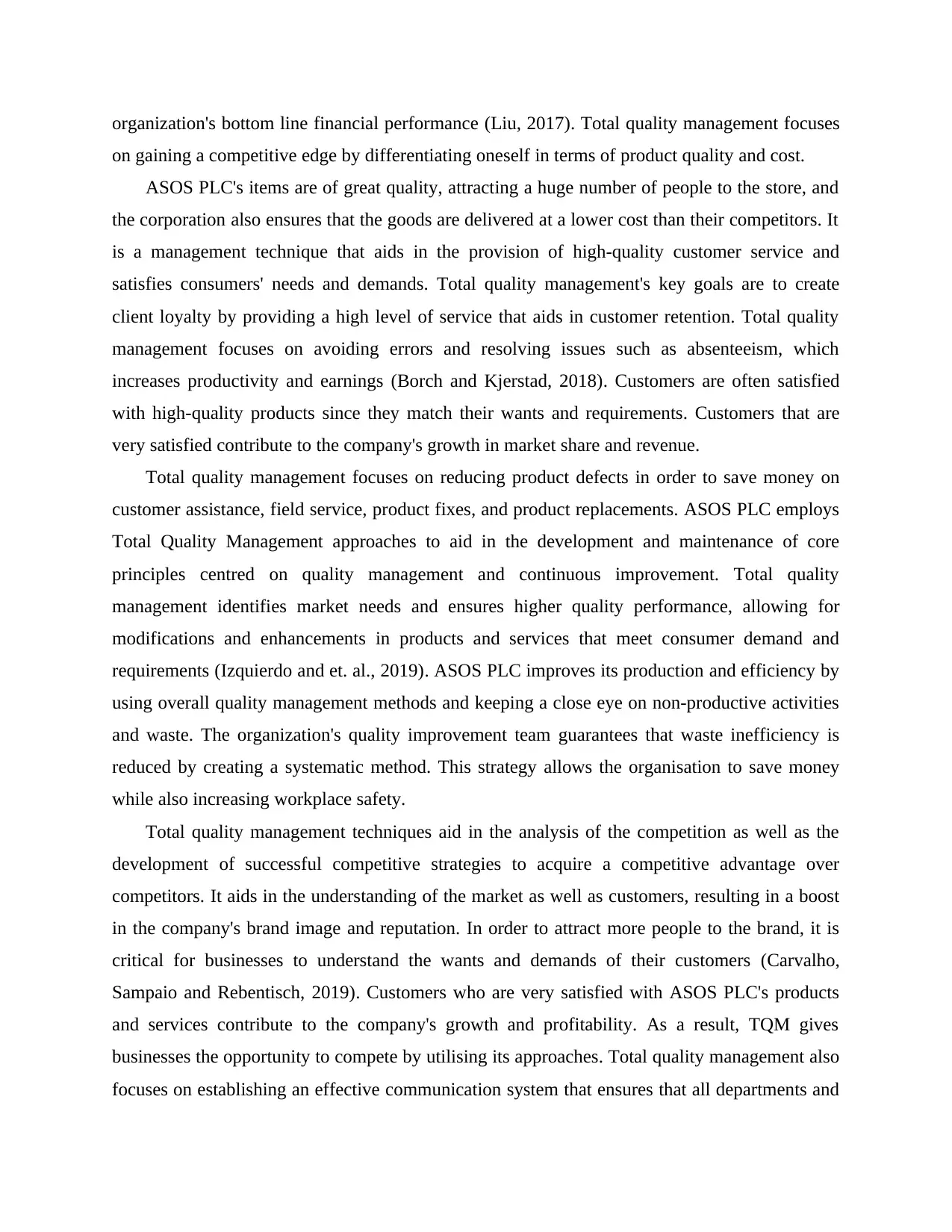
organization's bottom line financial performance (Liu, 2017). Total quality management focuses
on gaining a competitive edge by differentiating oneself in terms of product quality and cost.
ASOS PLC's items are of great quality, attracting a huge number of people to the store, and
the corporation also ensures that the goods are delivered at a lower cost than their competitors. It
is a management technique that aids in the provision of high-quality customer service and
satisfies consumers' needs and demands. Total quality management's key goals are to create
client loyalty by providing a high level of service that aids in customer retention. Total quality
management focuses on avoiding errors and resolving issues such as absenteeism, which
increases productivity and earnings (Borch and Kjerstad, 2018). Customers are often satisfied
with high-quality products since they match their wants and requirements. Customers that are
very satisfied contribute to the company's growth in market share and revenue.
Total quality management focuses on reducing product defects in order to save money on
customer assistance, field service, product fixes, and product replacements. ASOS PLC employs
Total Quality Management approaches to aid in the development and maintenance of core
principles centred on quality management and continuous improvement. Total quality
management identifies market needs and ensures higher quality performance, allowing for
modifications and enhancements in products and services that meet consumer demand and
requirements (Izquierdo and et. al., 2019). ASOS PLC improves its production and efficiency by
using overall quality management methods and keeping a close eye on non-productive activities
and waste. The organization's quality improvement team guarantees that waste inefficiency is
reduced by creating a systematic method. This strategy allows the organisation to save money
while also increasing workplace safety.
Total quality management techniques aid in the analysis of the competition as well as the
development of successful competitive strategies to acquire a competitive advantage over
competitors. It aids in the understanding of the market as well as customers, resulting in a boost
in the company's brand image and reputation. In order to attract more people to the brand, it is
critical for businesses to understand the wants and demands of their customers (Carvalho,
Sampaio and Rebentisch, 2019). Customers who are very satisfied with ASOS PLC's products
and services contribute to the company's growth and profitability. As a result, TQM gives
businesses the opportunity to compete by utilising its approaches. Total quality management also
focuses on establishing an effective communication system that ensures that all departments and
on gaining a competitive edge by differentiating oneself in terms of product quality and cost.
ASOS PLC's items are of great quality, attracting a huge number of people to the store, and
the corporation also ensures that the goods are delivered at a lower cost than their competitors. It
is a management technique that aids in the provision of high-quality customer service and
satisfies consumers' needs and demands. Total quality management's key goals are to create
client loyalty by providing a high level of service that aids in customer retention. Total quality
management focuses on avoiding errors and resolving issues such as absenteeism, which
increases productivity and earnings (Borch and Kjerstad, 2018). Customers are often satisfied
with high-quality products since they match their wants and requirements. Customers that are
very satisfied contribute to the company's growth in market share and revenue.
Total quality management focuses on reducing product defects in order to save money on
customer assistance, field service, product fixes, and product replacements. ASOS PLC employs
Total Quality Management approaches to aid in the development and maintenance of core
principles centred on quality management and continuous improvement. Total quality
management identifies market needs and ensures higher quality performance, allowing for
modifications and enhancements in products and services that meet consumer demand and
requirements (Izquierdo and et. al., 2019). ASOS PLC improves its production and efficiency by
using overall quality management methods and keeping a close eye on non-productive activities
and waste. The organization's quality improvement team guarantees that waste inefficiency is
reduced by creating a systematic method. This strategy allows the organisation to save money
while also increasing workplace safety.
Total quality management techniques aid in the analysis of the competition as well as the
development of successful competitive strategies to acquire a competitive advantage over
competitors. It aids in the understanding of the market as well as customers, resulting in a boost
in the company's brand image and reputation. In order to attract more people to the brand, it is
critical for businesses to understand the wants and demands of their customers (Carvalho,
Sampaio and Rebentisch, 2019). Customers who are very satisfied with ASOS PLC's products
and services contribute to the company's growth and profitability. As a result, TQM gives
businesses the opportunity to compete by utilising its approaches. Total quality management also
focuses on establishing an effective communication system that ensures that all departments and
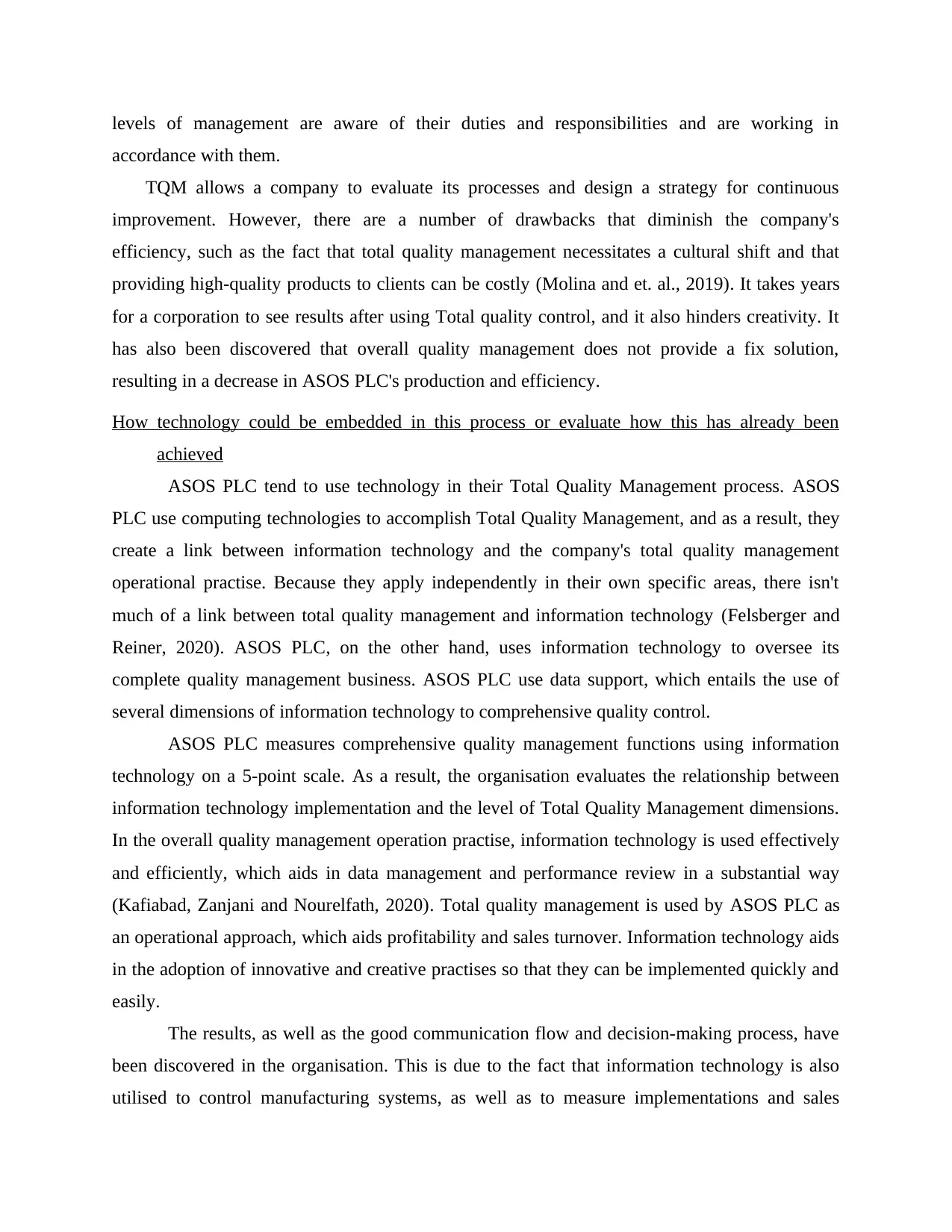
levels of management are aware of their duties and responsibilities and are working in
accordance with them.
TQM allows a company to evaluate its processes and design a strategy for continuous
improvement. However, there are a number of drawbacks that diminish the company's
efficiency, such as the fact that total quality management necessitates a cultural shift and that
providing high-quality products to clients can be costly (Molina and et. al., 2019). It takes years
for a corporation to see results after using Total quality control, and it also hinders creativity. It
has also been discovered that overall quality management does not provide a fix solution,
resulting in a decrease in ASOS PLC's production and efficiency.
How technology could be embedded in this process or evaluate how this has already been
achieved
ASOS PLC tend to use technology in their Total Quality Management process. ASOS
PLC use computing technologies to accomplish Total Quality Management, and as a result, they
create a link between information technology and the company's total quality management
operational practise. Because they apply independently in their own specific areas, there isn't
much of a link between total quality management and information technology (Felsberger and
Reiner, 2020). ASOS PLC, on the other hand, uses information technology to oversee its
complete quality management business. ASOS PLC use data support, which entails the use of
several dimensions of information technology to comprehensive quality control.
ASOS PLC measures comprehensive quality management functions using information
technology on a 5-point scale. As a result, the organisation evaluates the relationship between
information technology implementation and the level of Total Quality Management dimensions.
In the overall quality management operation practise, information technology is used effectively
and efficiently, which aids in data management and performance review in a substantial way
(Kafiabad, Zanjani and Nourelfath, 2020). Total quality management is used by ASOS PLC as
an operational approach, which aids profitability and sales turnover. Information technology aids
in the adoption of innovative and creative practises so that they can be implemented quickly and
easily.
The results, as well as the good communication flow and decision-making process, have
been discovered in the organisation. This is due to the fact that information technology is also
utilised to control manufacturing systems, as well as to measure implementations and sales
accordance with them.
TQM allows a company to evaluate its processes and design a strategy for continuous
improvement. However, there are a number of drawbacks that diminish the company's
efficiency, such as the fact that total quality management necessitates a cultural shift and that
providing high-quality products to clients can be costly (Molina and et. al., 2019). It takes years
for a corporation to see results after using Total quality control, and it also hinders creativity. It
has also been discovered that overall quality management does not provide a fix solution,
resulting in a decrease in ASOS PLC's production and efficiency.
How technology could be embedded in this process or evaluate how this has already been
achieved
ASOS PLC tend to use technology in their Total Quality Management process. ASOS
PLC use computing technologies to accomplish Total Quality Management, and as a result, they
create a link between information technology and the company's total quality management
operational practise. Because they apply independently in their own specific areas, there isn't
much of a link between total quality management and information technology (Felsberger and
Reiner, 2020). ASOS PLC, on the other hand, uses information technology to oversee its
complete quality management business. ASOS PLC use data support, which entails the use of
several dimensions of information technology to comprehensive quality control.
ASOS PLC measures comprehensive quality management functions using information
technology on a 5-point scale. As a result, the organisation evaluates the relationship between
information technology implementation and the level of Total Quality Management dimensions.
In the overall quality management operation practise, information technology is used effectively
and efficiently, which aids in data management and performance review in a substantial way
(Kafiabad, Zanjani and Nourelfath, 2020). Total quality management is used by ASOS PLC as
an operational approach, which aids profitability and sales turnover. Information technology aids
in the adoption of innovative and creative practises so that they can be implemented quickly and
easily.
The results, as well as the good communication flow and decision-making process, have
been discovered in the organisation. This is due to the fact that information technology is also
utilised to control manufacturing systems, as well as to measure implementations and sales
⊘ This is a preview!⊘
Do you want full access?
Subscribe today to unlock all pages.

Trusted by 1+ million students worldwide
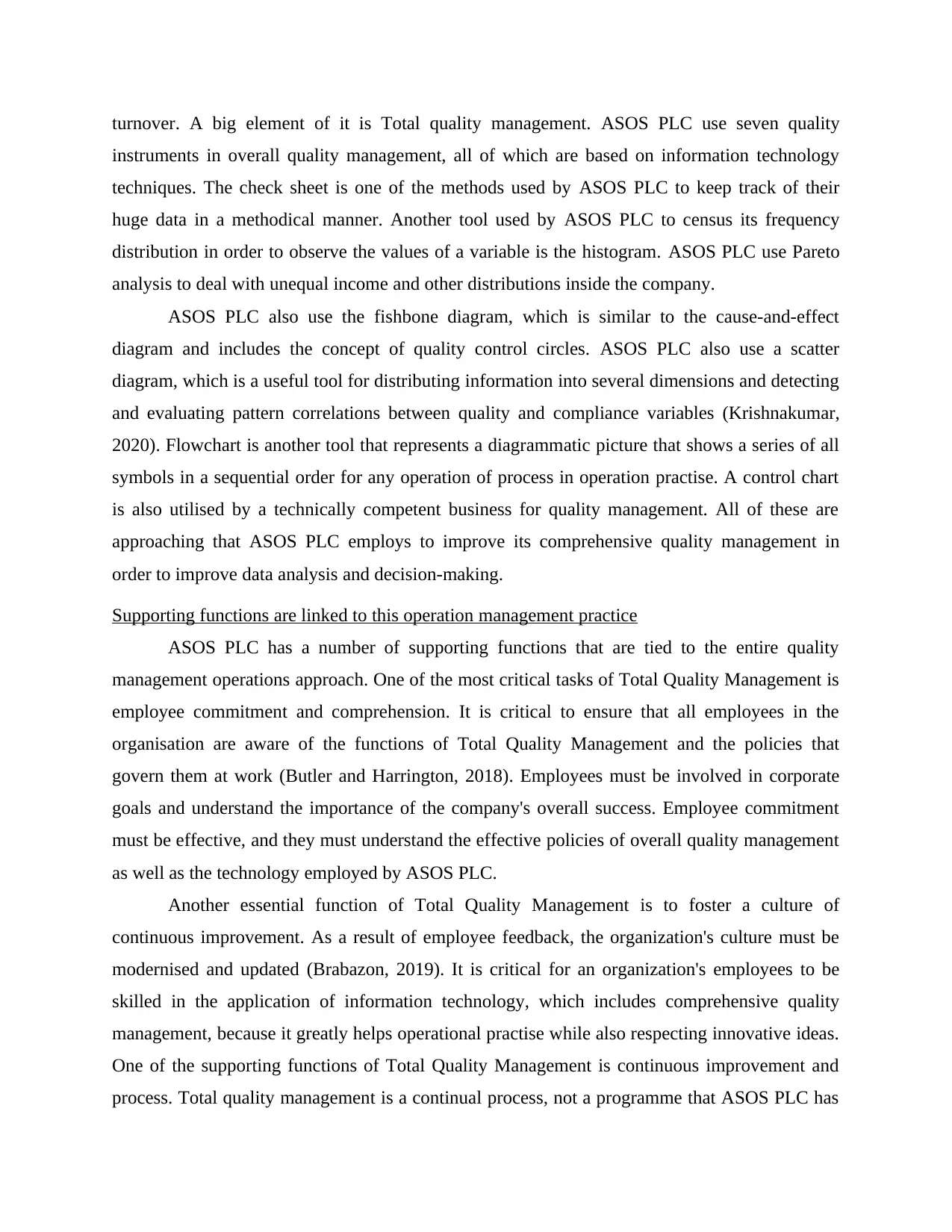
turnover. A big element of it is Total quality management. ASOS PLC use seven quality
instruments in overall quality management, all of which are based on information technology
techniques. The check sheet is one of the methods used by ASOS PLC to keep track of their
huge data in a methodical manner. Another tool used by ASOS PLC to census its frequency
distribution in order to observe the values of a variable is the histogram. ASOS PLC use Pareto
analysis to deal with unequal income and other distributions inside the company.
ASOS PLC also use the fishbone diagram, which is similar to the cause-and-effect
diagram and includes the concept of quality control circles. ASOS PLC also use a scatter
diagram, which is a useful tool for distributing information into several dimensions and detecting
and evaluating pattern correlations between quality and compliance variables (Krishnakumar,
2020). Flowchart is another tool that represents a diagrammatic picture that shows a series of all
symbols in a sequential order for any operation of process in operation practise. A control chart
is also utilised by a technically competent business for quality management. All of these are
approaching that ASOS PLC employs to improve its comprehensive quality management in
order to improve data analysis and decision-making.
Supporting functions are linked to this operation management practice
ASOS PLC has a number of supporting functions that are tied to the entire quality
management operations approach. One of the most critical tasks of Total Quality Management is
employee commitment and comprehension. It is critical to ensure that all employees in the
organisation are aware of the functions of Total Quality Management and the policies that
govern them at work (Butler and Harrington, 2018). Employees must be involved in corporate
goals and understand the importance of the company's overall success. Employee commitment
must be effective, and they must understand the effective policies of overall quality management
as well as the technology employed by ASOS PLC.
Another essential function of Total Quality Management is to foster a culture of
continuous improvement. As a result of employee feedback, the organization's culture must be
modernised and updated (Brabazon, 2019). It is critical for an organization's employees to be
skilled in the application of information technology, which includes comprehensive quality
management, because it greatly helps operational practise while also respecting innovative ideas.
One of the supporting functions of Total Quality Management is continuous improvement and
process. Total quality management is a continual process, not a programme that ASOS PLC has
instruments in overall quality management, all of which are based on information technology
techniques. The check sheet is one of the methods used by ASOS PLC to keep track of their
huge data in a methodical manner. Another tool used by ASOS PLC to census its frequency
distribution in order to observe the values of a variable is the histogram. ASOS PLC use Pareto
analysis to deal with unequal income and other distributions inside the company.
ASOS PLC also use the fishbone diagram, which is similar to the cause-and-effect
diagram and includes the concept of quality control circles. ASOS PLC also use a scatter
diagram, which is a useful tool for distributing information into several dimensions and detecting
and evaluating pattern correlations between quality and compliance variables (Krishnakumar,
2020). Flowchart is another tool that represents a diagrammatic picture that shows a series of all
symbols in a sequential order for any operation of process in operation practise. A control chart
is also utilised by a technically competent business for quality management. All of these are
approaching that ASOS PLC employs to improve its comprehensive quality management in
order to improve data analysis and decision-making.
Supporting functions are linked to this operation management practice
ASOS PLC has a number of supporting functions that are tied to the entire quality
management operations approach. One of the most critical tasks of Total Quality Management is
employee commitment and comprehension. It is critical to ensure that all employees in the
organisation are aware of the functions of Total Quality Management and the policies that
govern them at work (Butler and Harrington, 2018). Employees must be involved in corporate
goals and understand the importance of the company's overall success. Employee commitment
must be effective, and they must understand the effective policies of overall quality management
as well as the technology employed by ASOS PLC.
Another essential function of Total Quality Management is to foster a culture of
continuous improvement. As a result of employee feedback, the organization's culture must be
modernised and updated (Brabazon, 2019). It is critical for an organization's employees to be
skilled in the application of information technology, which includes comprehensive quality
management, because it greatly helps operational practise while also respecting innovative ideas.
One of the supporting functions of Total Quality Management is continuous improvement and
process. Total quality management is a continual process, not a programme that ASOS PLC has
Paraphrase This Document
Need a fresh take? Get an instant paraphrase of this document with our AI Paraphraser
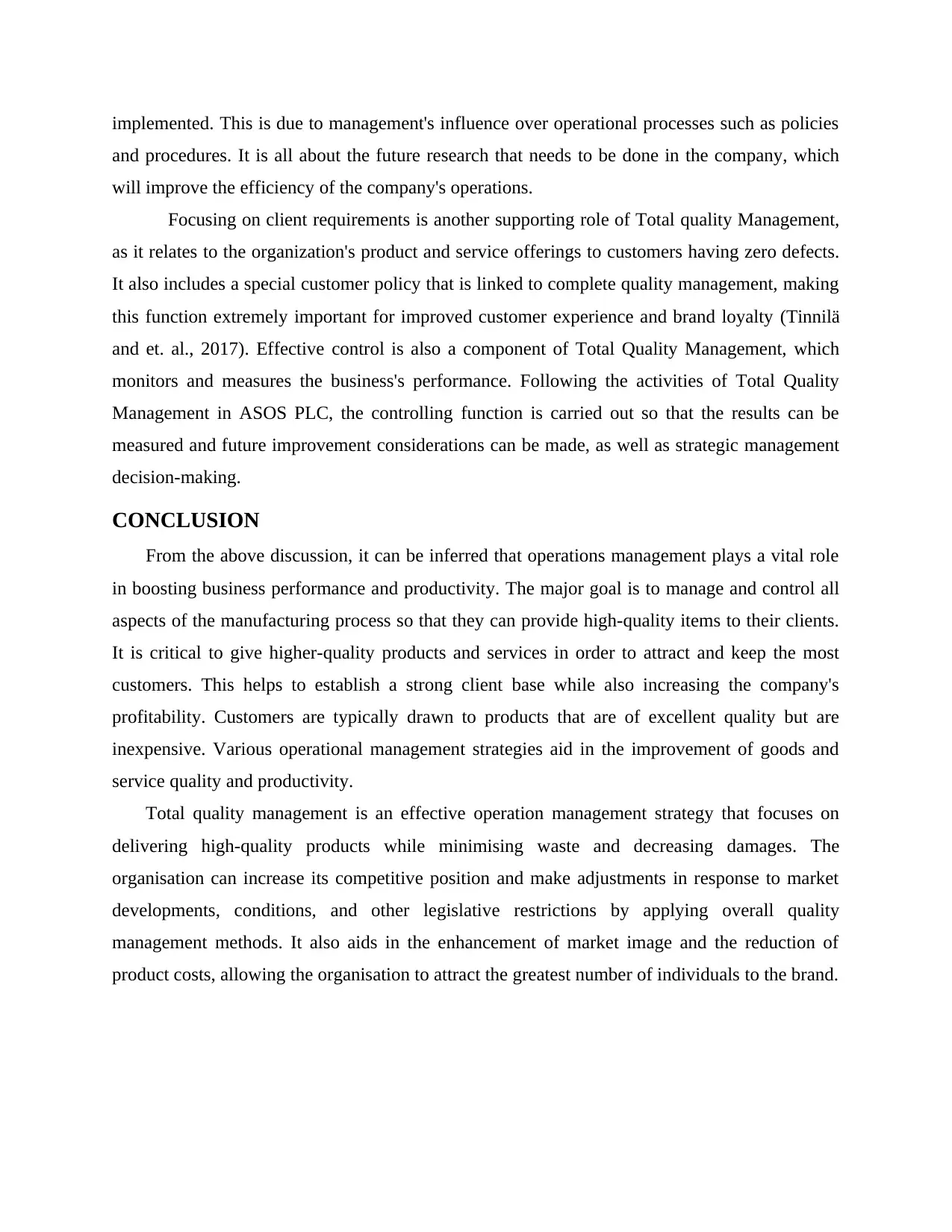
implemented. This is due to management's influence over operational processes such as policies
and procedures. It is all about the future research that needs to be done in the company, which
will improve the efficiency of the company's operations.
Focusing on client requirements is another supporting role of Total quality Management,
as it relates to the organization's product and service offerings to customers having zero defects.
It also includes a special customer policy that is linked to complete quality management, making
this function extremely important for improved customer experience and brand loyalty (Tinnilä
and et. al., 2017). Effective control is also a component of Total Quality Management, which
monitors and measures the business's performance. Following the activities of Total Quality
Management in ASOS PLC, the controlling function is carried out so that the results can be
measured and future improvement considerations can be made, as well as strategic management
decision-making.
CONCLUSION
From the above discussion, it can be inferred that operations management plays a vital role
in boosting business performance and productivity. The major goal is to manage and control all
aspects of the manufacturing process so that they can provide high-quality items to their clients.
It is critical to give higher-quality products and services in order to attract and keep the most
customers. This helps to establish a strong client base while also increasing the company's
profitability. Customers are typically drawn to products that are of excellent quality but are
inexpensive. Various operational management strategies aid in the improvement of goods and
service quality and productivity.
Total quality management is an effective operation management strategy that focuses on
delivering high-quality products while minimising waste and decreasing damages. The
organisation can increase its competitive position and make adjustments in response to market
developments, conditions, and other legislative restrictions by applying overall quality
management methods. It also aids in the enhancement of market image and the reduction of
product costs, allowing the organisation to attract the greatest number of individuals to the brand.
and procedures. It is all about the future research that needs to be done in the company, which
will improve the efficiency of the company's operations.
Focusing on client requirements is another supporting role of Total quality Management,
as it relates to the organization's product and service offerings to customers having zero defects.
It also includes a special customer policy that is linked to complete quality management, making
this function extremely important for improved customer experience and brand loyalty (Tinnilä
and et. al., 2017). Effective control is also a component of Total Quality Management, which
monitors and measures the business's performance. Following the activities of Total Quality
Management in ASOS PLC, the controlling function is carried out so that the results can be
measured and future improvement considerations can be made, as well as strategic management
decision-making.
CONCLUSION
From the above discussion, it can be inferred that operations management plays a vital role
in boosting business performance and productivity. The major goal is to manage and control all
aspects of the manufacturing process so that they can provide high-quality items to their clients.
It is critical to give higher-quality products and services in order to attract and keep the most
customers. This helps to establish a strong client base while also increasing the company's
profitability. Customers are typically drawn to products that are of excellent quality but are
inexpensive. Various operational management strategies aid in the improvement of goods and
service quality and productivity.
Total quality management is an effective operation management strategy that focuses on
delivering high-quality products while minimising waste and decreasing damages. The
organisation can increase its competitive position and make adjustments in response to market
developments, conditions, and other legislative restrictions by applying overall quality
management methods. It also aids in the enhancement of market image and the reduction of
product costs, allowing the organisation to attract the greatest number of individuals to the brand.
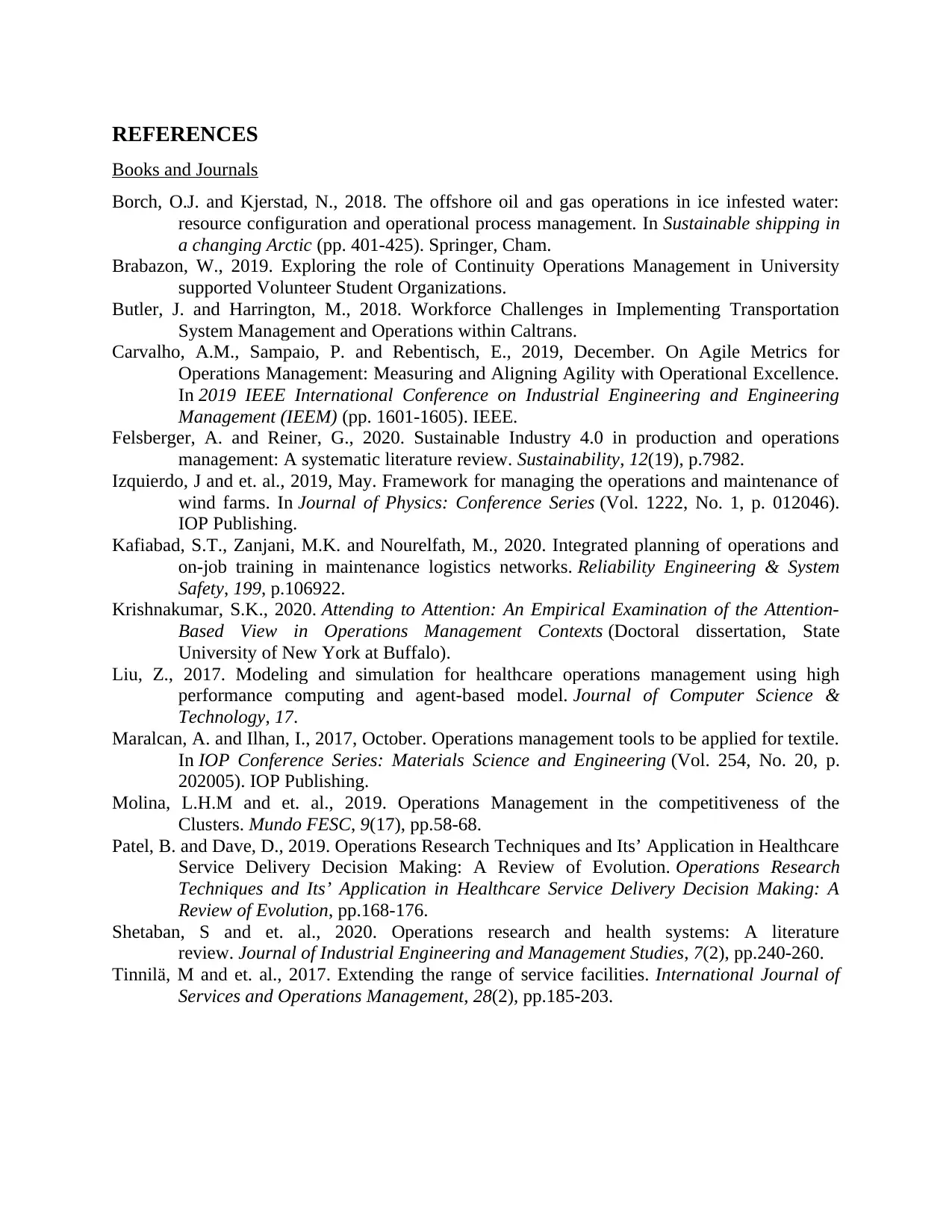
REFERENCES
Books and Journals
Borch, O.J. and Kjerstad, N., 2018. The offshore oil and gas operations in ice infested water:
resource configuration and operational process management. In Sustainable shipping in
a changing Arctic (pp. 401-425). Springer, Cham.
Brabazon, W., 2019. Exploring the role of Continuity Operations Management in University
supported Volunteer Student Organizations.
Butler, J. and Harrington, M., 2018. Workforce Challenges in Implementing Transportation
System Management and Operations within Caltrans.
Carvalho, A.M., Sampaio, P. and Rebentisch, E., 2019, December. On Agile Metrics for
Operations Management: Measuring and Aligning Agility with Operational Excellence.
In 2019 IEEE International Conference on Industrial Engineering and Engineering
Management (IEEM) (pp. 1601-1605). IEEE.
Felsberger, A. and Reiner, G., 2020. Sustainable Industry 4.0 in production and operations
management: A systematic literature review. Sustainability, 12(19), p.7982.
Izquierdo, J and et. al., 2019, May. Framework for managing the operations and maintenance of
wind farms. In Journal of Physics: Conference Series (Vol. 1222, No. 1, p. 012046).
IOP Publishing.
Kafiabad, S.T., Zanjani, M.K. and Nourelfath, M., 2020. Integrated planning of operations and
on-job training in maintenance logistics networks. Reliability Engineering & System
Safety, 199, p.106922.
Krishnakumar, S.K., 2020. Attending to Attention: An Empirical Examination of the Attention-
Based View in Operations Management Contexts (Doctoral dissertation, State
University of New York at Buffalo).
Liu, Z., 2017. Modeling and simulation for healthcare operations management using high
performance computing and agent-based model. Journal of Computer Science &
Technology, 17.
Maralcan, A. and Ilhan, I., 2017, October. Operations management tools to be applied for textile.
In IOP Conference Series: Materials Science and Engineering (Vol. 254, No. 20, p.
202005). IOP Publishing.
Molina, L.H.M and et. al., 2019. Operations Management in the competitiveness of the
Clusters. Mundo FESC, 9(17), pp.58-68.
Patel, B. and Dave, D., 2019. Operations Research Techniques and Its’ Application in Healthcare
Service Delivery Decision Making: A Review of Evolution. Operations Research
Techniques and Its’ Application in Healthcare Service Delivery Decision Making: A
Review of Evolution, pp.168-176.
Shetaban, S and et. al., 2020. Operations research and health systems: A literature
review. Journal of Industrial Engineering and Management Studies, 7(2), pp.240-260.
Tinnilä, M and et. al., 2017. Extending the range of service facilities. International Journal of
Services and Operations Management, 28(2), pp.185-203.
Books and Journals
Borch, O.J. and Kjerstad, N., 2018. The offshore oil and gas operations in ice infested water:
resource configuration and operational process management. In Sustainable shipping in
a changing Arctic (pp. 401-425). Springer, Cham.
Brabazon, W., 2019. Exploring the role of Continuity Operations Management in University
supported Volunteer Student Organizations.
Butler, J. and Harrington, M., 2018. Workforce Challenges in Implementing Transportation
System Management and Operations within Caltrans.
Carvalho, A.M., Sampaio, P. and Rebentisch, E., 2019, December. On Agile Metrics for
Operations Management: Measuring and Aligning Agility with Operational Excellence.
In 2019 IEEE International Conference on Industrial Engineering and Engineering
Management (IEEM) (pp. 1601-1605). IEEE.
Felsberger, A. and Reiner, G., 2020. Sustainable Industry 4.0 in production and operations
management: A systematic literature review. Sustainability, 12(19), p.7982.
Izquierdo, J and et. al., 2019, May. Framework for managing the operations and maintenance of
wind farms. In Journal of Physics: Conference Series (Vol. 1222, No. 1, p. 012046).
IOP Publishing.
Kafiabad, S.T., Zanjani, M.K. and Nourelfath, M., 2020. Integrated planning of operations and
on-job training in maintenance logistics networks. Reliability Engineering & System
Safety, 199, p.106922.
Krishnakumar, S.K., 2020. Attending to Attention: An Empirical Examination of the Attention-
Based View in Operations Management Contexts (Doctoral dissertation, State
University of New York at Buffalo).
Liu, Z., 2017. Modeling and simulation for healthcare operations management using high
performance computing and agent-based model. Journal of Computer Science &
Technology, 17.
Maralcan, A. and Ilhan, I., 2017, October. Operations management tools to be applied for textile.
In IOP Conference Series: Materials Science and Engineering (Vol. 254, No. 20, p.
202005). IOP Publishing.
Molina, L.H.M and et. al., 2019. Operations Management in the competitiveness of the
Clusters. Mundo FESC, 9(17), pp.58-68.
Patel, B. and Dave, D., 2019. Operations Research Techniques and Its’ Application in Healthcare
Service Delivery Decision Making: A Review of Evolution. Operations Research
Techniques and Its’ Application in Healthcare Service Delivery Decision Making: A
Review of Evolution, pp.168-176.
Shetaban, S and et. al., 2020. Operations research and health systems: A literature
review. Journal of Industrial Engineering and Management Studies, 7(2), pp.240-260.
Tinnilä, M and et. al., 2017. Extending the range of service facilities. International Journal of
Services and Operations Management, 28(2), pp.185-203.
⊘ This is a preview!⊘
Do you want full access?
Subscribe today to unlock all pages.

Trusted by 1+ million students worldwide
1 out of 9
Related Documents
Your All-in-One AI-Powered Toolkit for Academic Success.
+13062052269
info@desklib.com
Available 24*7 on WhatsApp / Email
![[object Object]](/_next/static/media/star-bottom.7253800d.svg)
Unlock your academic potential
Copyright © 2020–2025 A2Z Services. All Rights Reserved. Developed and managed by ZUCOL.




